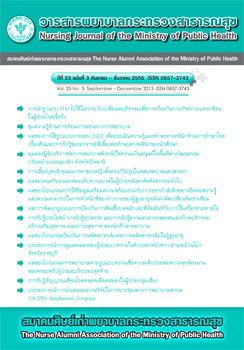ผลของดนตรีบรรเลงต่อระดับความปวดในผู้ป่วยหลังผ่าตัดศัลยกรรมทั่วไป
Main Article Content
Abstract
การวิจัยครั้งนี้เป็นการวิจัยแบบกึ่งทดลอง มีวัตถุประสงค์เพื่อศึกษาผลของดนตรีบรรเลงต่อระดับความปวด ในผู้ป่วยหลังผ่าตัดศัลยกรรมทั่วไป โดยใช้แนวคิดทฤษฏีควบคุมประตูและทฤษฎีควบคุมความปวดภายใน โดยการ ประเมินความปวดของผู้ป่วย และจัดการกับความปวดด้วยการใช้ดนตรีบรรเลงร่วมกับการใช้ยา กลุ่มตัวอย่าง คือ ผู้ป่วยหลังผ่าตัดศัลยกรรมทั่วไป โดยการเลือกแบบเจาะจงตามเกณฑ์ จำนวน 20 คน แบ่งเป็น 2 กลุ่ม โดย กลุ่มแรกเป็นกลุ่มควบคุม 10 คน และกลุ่มที่สองเป็นกลุ่มทดลอง 10 คน เครื่องมือที่ใช้ในการทดลองประกอบด้วย แบบบันทึกข้อมูลทั่วไปของผู้ป่วย โปรมแกรมการฟังดนตรีบรรเลง แบบวัดความรู้สึกปวดหลังผ่าตัด แบบบันทึก การใช้ยาแก้ปวด ความเชื่อมั่นของแบบประเมินความปวด = 0.79 วิเคราะห์ข้อมูลความปวด โดยการแจกแจง ความถี่ ร้อยละ ค่าเฉลี่ย ส่วนเบี่ยงเบนมาตรฐาน เปรียบเทียบความแตกต่างก่อนและหลังการทดลอง โดยใช้ สถิติที (pair t-test) และเปรียบเทียบความแตกต่างระหว่างหลังการทดลองในกลุ่มทดลองและกลุ่มควบคุม โดยใช้ สถิติที (independent t - test)
ผลการวิจัยพบว่า หลังผ่าตัด 48 ชั่วโมง ผู้ป่วยที่ได้รับการฟังดนตรีบรรเลงมีคะแนนเฉลี่ยความรู้สึกปวดต่ำ กว่ากลุ่มควบคุมอย่างมีนัยสำคัญทางสถิติที่ระดับ .05 (t =-2.27, p=.04) ผู้ป่วยที่ได้รับการฟังดนตรีมีคะแนน เฉลี่ยความรู้สึกปวดหลังทดลองต่ำกว่าก่อนทดลองอย่างมีนัยสำคัญทางสถิติที่ระดับ .05 (t= 7.154, p=.000) ผู้ป่วยที่ได้รับการฟังดนตรีมีจำนวนครั้งของการใช้ยาระงับปวดไม่แตกต่างกลุ่มควบคุมในระยะ 48 ชั่วโมง หลังผ่าตัด (t=-.802, p=.43 )
จากผลการศึกษาครั้งนี้ สามารถนำดนตรีบรรเลงมาใช้ในผู้ป่วยหลังผ่าตัดในระยะ 48 ชั่วโมงแรก เพื่อ ควบคุมและลดความปวด เป็นการเพิ่มประสิทธิภาพและคุณภาพในการจัดการกับความปวดของบุคคลากรด้าน สุขภาพ
The Effects of Music Therapy on Post-operative Pain.
Penprapa Im-erb*
Wreewon Kongchoom.*
Koranit Rimsueb and et al*
Abstract
The purpose of this quasi-experimental research was to study the effects of music therapy on post-operative pain of patients undergoing general surgery. The music therapy used the concepts of gate control theory and endogenous pain control theory in order to assess pain of the patients. Pain management consisted of both pharmacology and music therapy. The participants were purposively selected and consisted of ten patients listening to music (experimental group) and ten patients notlistening to music (controlled group). The instruments included music therapy, demographic questionnaire, pain level questionnaire and analgesic record. The reliability of the pain level questionnaire was 0.79. Frequency, percentage, mean, standard deviation, and t-test were used for analyzing the data.
The results showed that at 48 hours post-surgery, the mean score of painlevel in the experimental group was significantly less than control group (t =- 2.27, p =0.04) and the post-experiment mean score of pain level in the experimental group was also significantly less than pre-experiment (t = 7.154, p <0.000)
The results of this study suggested that the music therapy could be used for 48 hour post-surgery patients in order to control and relieve pain and it might increase efficiency and quality in pain management of people as well.
* Registered Nurse, Nakhonayok HospitaArticle Details
บทความและรายงานวิจัยในวารสารพยาบาลกระทรวงสาธารณสุข เป็นความคิดเห็นของ ผู้เขียน มิใช่ของคณะผู้จัดทำ และมิใช่ความรับผิดชอบของสมาคมศิษย์เก่าพยาบาลกระทรวงสาธารณสุข ซึ่งสามารถนำไปอ้างอิงได้

